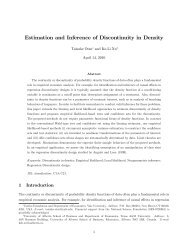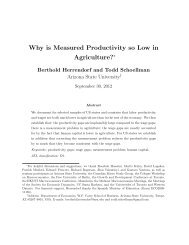12 Appendix 4: The Proof That All KFCs Have the 3MPropertySuppose not. Then for some E e ∈ S <strong>and</strong> E 0 ∈ SE e ,theD-restricted KFCN eE (·) :S eE → P w ∗ f(X)is such that there exists a pair of disjoint closed sets, F 1 <strong>and</strong> F 2 in D( e E), <strong>and</strong>anopen ball, B δ 0(E 0 ) ∩ S eE , δ 0 > 0, containingtwoD-equivalent Ky Fan sets, E 1 <strong>and</strong> E 2in S e E , such that N e E (E1 ) ∩ F 1 = ∅ <strong>and</strong> N e E (E2 ) ∩ F 2 = ∅,but such that for all E 3 ∈ B hw ∗ ×w ∗ (3δ 0 ,E 0 ) ∩ S e EN eE (E 3 ) ∩ [F 1 ∪ F 2 ] 6= ∅.First, given that NE e (·) is an USCO, under [A-1] there are disjoint open sets Uisuch that F i ⊂ U i <strong>and</strong> NE e (Ei ) ∩ U i = ∅, i =1, 2. Thus,N eE (E 3 ) ∩ [F 1 ∪ F 2 ] 6= ∅ for all E 3 ∈ B hw ∗ ×w ∗ (3δ 0 ,E 0 ) ∩ S eE ,implies thatN e E (E3 ) ∩ [U 1 ∪ U 2 ] 6= ∅ for all E 3 ∈ B hw ∗ ×w ∗ (3δ 0 ,E 0 ) ∩ S e E . ⎫⎬⎭(91)We will show that (91) leads to a contradiction by constructing a Ky Fan set,E ∗ ∈ S eE with E ∗ ∈ B hw ∗ ×w ∗ (3δ 0 ,E 0 ) such thatN eE (E ∗ ) ∩ [U 1 ∪ U 2 ] 6= ∅ (*),<strong>and</strong> such that (*) implies that N eE (E i ) ∩ U i 6= ∅ for some i =1<strong>and</strong>/or 2.c<strong>and</strong>idate for such a set is given byOurE ∗ := [E 1 ∩ (X × U 2 ) c ] ∪ [E 2 ∩ (X × U 1 ) c ] (92)where(X × U i ) c := © (y, x) ∈ X × X : x/∈ U iª .To complete the proof we must show that, (1) E ∗ ∈ SE e ,(2)E∗ ∈ B hw ∗ ×w ∗ (3δ 0 ,E 0 ),<strong>and</strong> (3) NE e (E∗ ) ∩ £ U 1 ∪ U 2¤ 6= ∅⇒NE e (Ei ) ∩ U i 6= ∅ for some i =1<strong>and</strong>/or 2.(1) E ∗ ∈ SE e : It is easy to see that E∗ ∈ P w ∗ w ∗ f(X × X). Moreover, becauseE i ∈ S eE i =1, 2, it is easy to see that (Z1) holds for E ∗ .Thus,D(E ∗ ) is nonempty,w ∗ -closed, <strong>and</strong> convex <strong>and</strong>D(E ∗ )=R(E ∗ )=D( e E).Also, it is easy to see that (Z2) holds for E ∗ .Thus,(y, y) ∈ E ∗ for all y ∈ D(E ∗ ).It remains to show that for all x ∈ R(E),{y ∈ D(E ∗ ):(y, x) /∈ E ∗ }54
is convex or empty.Let x ∈ U 1 , then because U 1 <strong>and</strong> U 2 are disjoint,{y ∈ D(E ∗ ):(y, x) /∈ E ∗ } = © y ∈ D(E ∗ ):(y,x) /∈ E 1ª ,a convex or empty set because E 1 ∈ S eE .Let x ∈ U 2 , then because U 1 <strong>and</strong> U 2 are disjoint,{y ∈ D(E ∗ ):(y, x) /∈ E ∗ } = © y ∈ D(E ∗ ):(y,x) /∈ E 2ª ,a convex or empty set because E 2 ∈ S e E .Let x ∈ D(E ∗ )\U 1 ∪ U 2 .Then{y ∈ D(E ∗ ):(y, x) /∈ E ∗ }= © y ∈ D(E ∗ ):(y, x) /∈ E 1ª ∩ © y ∈ D(E ∗ ):(y, x) /∈ E 2ª ,the later being the intersection of convex or empty sets. Therefore,is convex or empty.(2) E ∗ ∈ B hw ∗ ×w ∗ (3δ 0 ,E 0 ):Wehave<strong>and</strong> by the triangle inequality,{y ∈ D(E ∗ ):(y, x) /∈ E ∗ }E ∗ =[E 1 ∩ (X × U 2 ) c ] ∪ [E 2 ∩ (X × U 1 ) c ] (93)h w ∗ ×w ∗(E1 ,E 2 ) ≤ h w ∗ ×w ∗(E1 ,E 0 )+h w ∗ ×w ∗(E2 ,E 0 ) < 2δ 0 ,<strong>and</strong>h w ∗ ×w ∗(E∗ ,E 0 ) ≤ h w ∗ ×w ∗(E∗ ,E 1 )+h w ∗ ×w ∗(E1 ,E 0 ).(94)We know already that h w ∗ ×w ∗(E1 ,E 0 ) < δ 0 .Considerh w ∗ ×w ∗(E∗ ,E 1 ).Wehaveh w ∗ ×w ∗(E∗ ,E 1 ):=max © e w ∗ ×w ∗(E∗ ,E 1 ),e w ∗ ×w ∗(E1 ,E ∗ ) ª .It is easy to check that,e w ∗ ×w ∗(E∗ ,E 1 )=sup (y,x)∈E ∗ ρ w ∗ ×w ∗((y, x),E1 )=sup (y,x)∈[E 2 ∩(X×U 1 ) c ] ρ w ∗ ×w ∗((y,x),E1 )≤ sup (y,x)∈E 2 ρ w ∗ ×w ∗((y, x),E1 )=e w ∗ ×w ∗(E2 ,E 1 ).To show that e w ∗ ×w ∗(E1 ,E ∗ ) ≤ e w ∗ ×w ∗(E1 ,E 2 ) observe thate w ∗ ×w ∗(E1 ,E ∗ )=sup (y,x)∈E 1 ρ w ∗ ×w ∗((y, x),E∗ )=sup (y,x)∈E 1 ρ w ∗ ×w ∗((y, x), [E1 \(X × U 2 )] ∪ [E 2 \(X × U 1 )]).55
- Page 5: cally approximated by continuous fu
- Page 12 and 13: the set x 0 x 1 ∈ C w ∗ f(X) is
- Page 14 and 15: defined on some probability space,
- Page 16 and 17: contains at most one arc (i.e., ¯
- Page 18 and 19: into the collection of Ky Fan sets
- Page 20 and 21: 3.1 Best Response MappingsLetting p
- Page 22 and 23: 4.1 Nikaido-Isoda FunctionsWith eac
- Page 24 and 25: Because Φ(z) × Φ(z) is w ∗ ×
- Page 26 and 27: where for all n, C n ∈ S E n,then
- Page 28 and 29: Definition 4 (The 3M Property - The
- Page 30 and 31: Given (48) and the fact that for n
- Page 32 and 33: We note that if m(z) ∈ P w ∗ f(
- Page 34 and 35: 6.3 AK Convergence of Minimal Nash
- Page 36 and 37: and Gr ρZ ×w ∗f ∗ (·) is the
- Page 38 and 39: In particular, for all n ≥ N 0 an
- Page 40 and 41: the cutting defined by the cut poin
- Page 42 and 43: According to our main result, under
- Page 44 and 45: By our main approximation result, f
- Page 46 and 47: 9 Appendix 1: USCO FundamentalsIn t
- Page 48 and 49: 9.3 Equi-QuasicontinuityIn order to
- Page 50 and 51: 9.5 Dense SelectionsFor each F ∈
- Page 52 and 53: 10 Appendix 2: The Proof of Lemma 8
- Page 54 and 55: Noting that if E ∈ D eE ,thenn eE
- Page 58 and 59: Letting E 1 =[E 1 \(X × U 2 )] ∪
- Page 60 and 61: [10] Bryant, V. W. (1970) “The Co
- Page 62: [42] Ward, L. E., Jr. (1958) “A F






